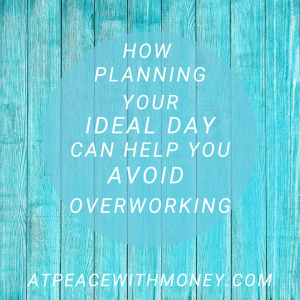How Planning Your Ideal Day Can Help You Avoid Overworking

If you’re a small business owner, you’re likely to be familiar with the word “grind.” Owning a small business is hard work. You don’t need me to tell me that. Especially if you’re striving to support yourself or a family through your work, you work hard to meet your needs. Today I want to suggest an exercise that can help you take a look at your work life without being caught in the hustle. By planning your ideal work day, you can avoid overworking. How? Let’s jump in and I’ll show you:
How Much Do You Want to Work?
Though it might feel frivolous, especially if you’re used to long hours or a tight schedule, go ahead and ask yourself this question. It’s important to keep a vision in mind. Especially so if you’re self-employed, because you’re the boss! So, would like to work 25 hours a week? 6 hours a day? Think about the other facets of your life – how could you find balance?
Now, compare this with how much you are currently working. There’s probably a difference. Start thinking about ways to close the gap.
Your Schedule Bone Is Connected to Your Pricing Bone
I love this saying from Ariane Trelaun, a fellow bookkeeper and self-described business witch. The point she puts across here is that how much you need to work is directly connected to how much you charge for that work. So, if you need to work 60 hours a week at the rate you’re charging now, imaging upping that rate by a couple bucks. Maybe you could ease back to 40 instead! Doing this math requires being aware of your expenses, and setting income goals based on them.
Try taking a look at your expenses, and how much you’d like to work. Ask yourself, “How much do I need to charge to work that amount?” Doing so can bring you more awareness of why you work as much as you do, and how you can start to limit that. For more thoughts on considering what you make as a business owner, check out this article.
Business, Not Busy-ness
 It’s important to note that beyond income needs, there are many other reasons why we might find it difficult to put a cap on our work hours. Many people use work as a coping mechanism, or pride themselves on long hours. Being busy is not a badge of honor. In the long run, busying yourself with your business can lead to solopreneur burnout and a lack of fulfillment in your business. The more you choose to set up your business in a restorative way now, the more it will serve you down the road.
It’s important to note that beyond income needs, there are many other reasons why we might find it difficult to put a cap on our work hours. Many people use work as a coping mechanism, or pride themselves on long hours. Being busy is not a badge of honor. In the long run, busying yourself with your business can lead to solopreneur burnout and a lack of fulfillment in your business. The more you choose to set up your business in a restorative way now, the more it will serve you down the road.
I hope this exercise helps you think through the way you’re structuring your work schedule, and encourages you to find ways out of overwork patterns! If you’d like some personalized help with any of this, please check out my services and schedule a discovery call.
Angela
Image: Slava Keyzman





 I know they say “Leap and the net will appear,” but in order to take care of yourself financially, I think it’s best to take the leap only when you’ve already constructed at least some of that net for yourself. I understand this is difficult territory. It can be hard to know when you might make more money if you’re able to work on your hustle full time, rather than playing it safe and keeping it on the side. My advice is to think carefully and critically and make sure you have the resources to take care of yourself!
I know they say “Leap and the net will appear,” but in order to take care of yourself financially, I think it’s best to take the leap only when you’ve already constructed at least some of that net for yourself. I understand this is difficult territory. It can be hard to know when you might make more money if you’re able to work on your hustle full time, rather than playing it safe and keeping it on the side. My advice is to think carefully and critically and make sure you have the resources to take care of yourself!
